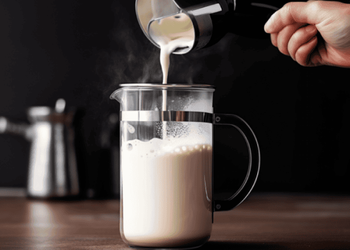
Milk Frother vs Steamer: Know The Exact Differences

Do you whisk up that microfoam with a frother or use the steam wand's magic? As a coffee enthusiast, you might have faced the frother vs steamer dilemma that stems from the textures each tool promises.
While the frother can entice you with its microfoam potential, ideal for lattes, the steamer, boasts its steaming powers, leaning towards cappuccinos. Your choice hinges on your specific taste preference—smooth and creamy or steamy and warm.
This dilemma reflects the quest for a personalized coffee experience, where the decision to froth or steam becomes pivotal in achieving that desired texture for your drink.
In this blog, I will tell you the unique features each tool brings to your coffee game. We'll break down the technicalities, lay out the pros and cons, and guide you toward making an informed choice based on your taste preferences.
Whether you're a latte lover or a cappuccino person, this blog promises clarity on which tool aligns best with your coffee cravings. Get ready to unravel the mysteries and elevate your home coffee experience like never before.
Milk Frother Overview
What is a Milk Frother?
A milk frother is a versatile tool designed to create the coveted frothy milk texture essential for various coffee delights. It operates by introducing air into the milk, transforming it into a velvety, foamy consistency that enhances both the visual appeal and taste of your beverages.
Types of Milk Frother
1) Handheld Milk Frother
A handheld milk frother, also known as a milk whisk or a milk frother wand, is a compact and portable option for achieving frothy textures in your beverages.
This battery-operated device generally features a whisk at the end that spins rapidly to create microfoam. It's easy to use and suitable for small-scale frothing, making it a popular choice for individuals who enjoy occasional frothy drinks.
2) Electric Milk Frother
Electric milk frothers are countertop appliances designed specifically for frothing milk. These devices come with a dedicated frothing whisk or attachment and often offer different settings for frothing or heating milk.
Some advanced models can even accommodate various types of milk, including plant-based alternatives. Electric frothers are suitable for those who want consistent and hands-free frothing with minimal effort.
How Does a Milk Frother Work?
A milk frother whisks air into the milk, creating microbubbles that lend a frothy texture. It's adept at crafting foam suitable for latte art and achieving a velvety texture that complements various coffee beverages.
Pros
1) Handheld frothers are portable and convenient.
2) Ideal for crafting intricate latte art.
3) Works well with various types of milk, including dairy and plant-based alternatives.
Cons
1) May produce foam that lacks the density of that created by a steamer.
2) Some frothers may not heat the milk adequately.
Buy Variable Temperature and Froth Thickness Frother from HERE.
Milk Steamer Overview
What is a Milk Steamer?
A milk steamer, often integrated into espresso machines, is designed to heat milk to create a smooth and creamy texture.
It is a crucial component in preparing beverages like lattes and cappuccinos, offering a different approach to milk texturing compared to frothers.
Types of Milk Steamer
1) Automatic Steam Wand
An automatic milk steamer is a convenient and user-friendly appliance designed for effortless milk steaming. These devices often come with programmable settings, allowing you to achieve your preferred milk temperature and texture with the push of a button.
Automatic milk steamers are ideal for those who prioritize convenience and consistency in their coffee-making routine.
2) Manual Steam Wand
Manual milk steamers, commonly found in traditional espresso machines, require a hands-on approach to achieve the desired milk texture. Operated by turning a steam valve, these steamers give you direct control over the frothing process.
While they may demand a bit of practice to master, manual steamers offer a more personalized touch, making them popular among enthusiasts who enjoy fine-tuning their milk's texture.
How Does a Milk Steamer Work?
A milk steamer heats the milk by releasing steam through a wand into its surface. The steam increases the temperature while creating a finely textured microfoam, resulting in a creamy consistency.
Pros
1) Produces dense, high-quality microfoam.
2) Heats the milk efficiently.
3) Ideal for crafting beverages in a coffee shop setting.
Cons
1) Using a steam wand requires some practice.
2) Generally integrated into espresso machines, limiting portability.
Buy an electric milk steamer from HERE.
Milk Frother vs Steamer: Quick Comparison
1) Frothing Capacity
If you're looking to froth small quantities of milk, a frother is the go-to choice. On the other hand, if your coffee endeavors involve larger volumes of frothed milk, a steamer is better suited for the task.
2) Foam Quality
When it comes to the quality of foam, a frother excels at creating light and airy foam, perfect for those who prefer a delicate texture. Conversely, a steamer produces dense, high-quality microfoam, catering to those who seek a richer and creamier consistency.
3) Cost
Consider your budgetary constraints. Generally, frothers are more affordable, making them an attractive option for those mindful of their coffee-making expenses. In contrast, steamers may represent a pricier investment.
4) Ease of Use
For a user-friendly experience with a minimal learning curve, a frother is the way to go. On the other hand, a steamer may require some practice to achieve optimal frothing results, making it more suitable for those willing to invest time in mastering the art.
5) Portability
If portability is a key consideration, especially for home use, a frother is a more suitable choice due to its compact and portable nature. Steamers, typically integrated into espresso machines, are less portable but offer a comprehensive solution for a range of coffee beverages.
6) Hot Milk Suitability
Consider the efficiency of heating milk. While frothers may not heat milk as efficiently, steamers excel in efficiently heating milk to the desired temperature, ensuring a warm and comforting cup of coffee.
7) Cold Foam Suitability
If your coffee cravings lean towards cold foam creations, a frother often proves better suited for crafting the perfect cold foam. Steamers may have limitations in achieving the desired cold foam consistency.
8) Ease of Cleaning
In terms of cleaning, frothers generally score well in terms of ease. They are straightforward to clean, requiring minimal effort. On the other hand, steamers demand diligent cleaning, particularly due to the presence of steam components, necessitating careful maintenance to ensure optimal performance.
Milk Frother or Steaming Wand: Which should you choose?
1) Personal Preference: Consider your preferred coffee beverages and the texture of the milk you enjoy.
2) Skill Level: A milk frother may be the better choice if you value simplicity. A steamer could be suitable if you enjoy hands-on processes and are willing to invest time in learning.
3) Volume: For individual use and small quantities, a frother may suffice. For high-volume settings or if you're crafting beverages for multiple people, a steamer may be more efficient.
4) Budget: Assess your budget and consider the initial investment and long-term costs associated with each option
Wrapping up
For coffee lovers like you, choosing between a milk frother and a steamer is like picking the perfect tool for your daily cup.
While deciding between these two, think about what suits your taste, budget, and ease of use. Whether you go for the easy vibe of a frother or the fancy touch of a steamer, it's all about making your coffee moments awesome.
So, take your pick, keep sipping, and enjoy the simple joy each cup brings to your coffee-loving heart!

I am a barista by profession hailing from NC. My journey began in my late teens when I started working as a barista in a local coffee shop. My passion for coffee quickly became evident as I immersed myself in the art of espresso extraction, latte art ...



